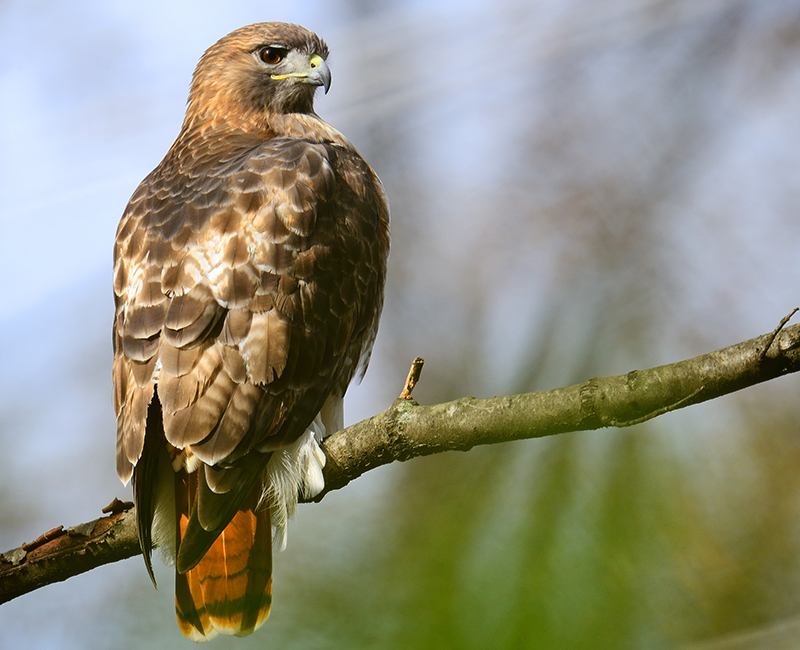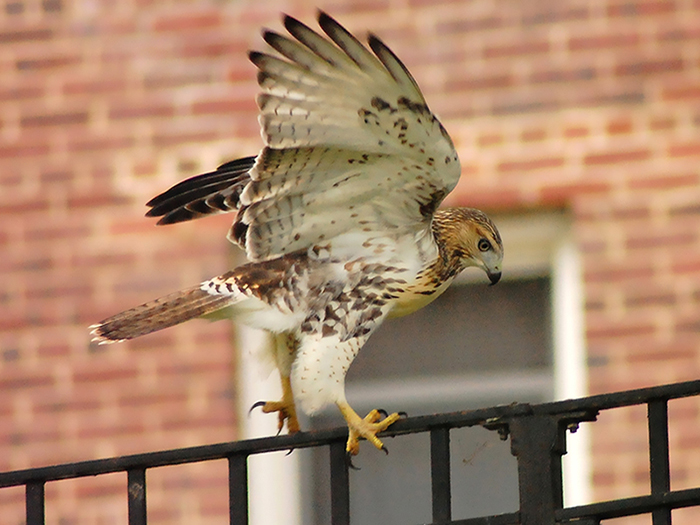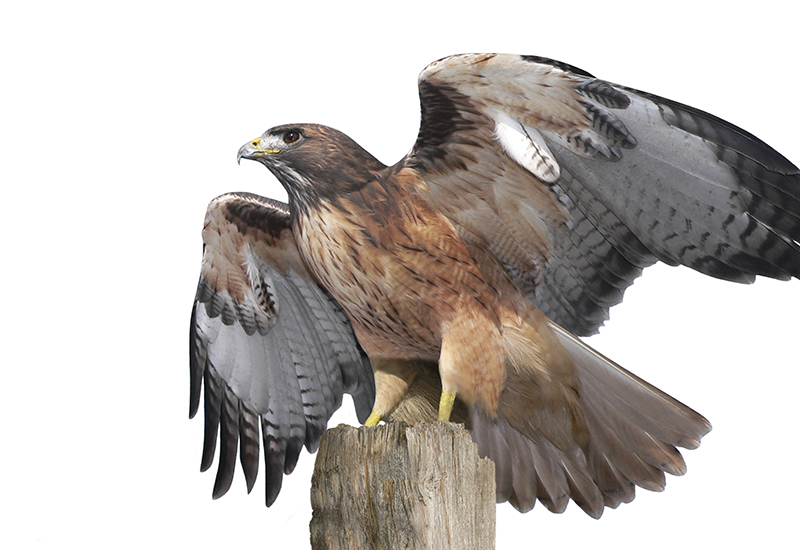
 WildlifeNYC311
WildlifeNYC311 Search all NYC.gov websites
Search all NYC.gov websites
Red-Tailed Hawks
Red-Tailed Hawk (Buteo jamaicensis)

A red-tailed hawk perched on a tree, searching for prey.
Introduction
In many ways, the relationship between New Yorkers and red-tailed hawks (Buteo jamaicensis) is the ideal of human-wildlife coexistence. They provide free pest control for the city, with a majority of their diet consisting of rats and mice. In turn, the city works to cut down on the use of rat poisons in areas where the hawks nest so that they do not accidentally eat poisoned rodents. City buildings and bridges also provide ideal nesting sites for urban hawks. It is an arrangement that benefits everyone involved—except, obviously, the rodents.
And that’s to say nothing of the enjoyment that red-tailed hawks have provided to New Yorkers throughout the years. Pale Male, a hawk that has called Manhattan home since 1990, has gained a following so large that he has been featured in films and children’s books. Other hawks throughout the city have garnered their share of attention as well, inspiring popular live video feeds of their nests. Between providing extermination and entertainment, red-tailed hawks are working hard to earn a place in the hearts of their fellow New Yorkers.
A red-tailed hawk coming in for a landing.
General Information
Background
Red-tailed hawks are the most common hawk found in North America. They can be seen throughout the United States, Canada, Mexico, and Central America. Red-tailed hawks can be found in many different habitats, including open fields, deserts, parks, woodlands, and forests. In New York City, red-tailed hawks have been spotted soaring over Fifth Avenue, nesting inside Flushing Meadow Park’s Unisphere, and hunting above Washington Square Park. They usually occupy the same territory on a year-to-year basis.Maintaining a sense of personal space in New York City is a valuable but difficult task. Male and female red-tailed hawks understand this, and can be aggressive in terms of protecting their nests and defending their territories. Their nests are comprised of twigs, pine needles, and other plant material they find in local parks and green spaces. Nests are often constructed on trees or on buildings about 13 to 70 feet off the ground. Here in New York City, nests have appeared atop the RFK Bridge and on the ledges of college buildings belonging to CUNY and NYU. The average lifespan of red-tailed hawks is 12 years in the wild, although they can reach 30 years in captivity.
In early April, the female will lay one to five eggs. Males and females will take turns incubating the eggs for 28 to 35 days until they are ready to hatch. The parents typically take care of their young for up to six weeks until they are ready to fly. Once they can fly, the young will hunt independently of their parents.
Red-tailed hawks hunt during the day, and can sometimes be seen gliding over the city’s parks looking for their next meal. Their sharp eyesight helps them spot prey in open areas. In New York City, hawks will perch on high platforms like telephone poles and wait for prey from above, then swoop down and capture them with their talons. They will adapt their diet to whatever is seasonally available. They mostly prey on rodents, reptiles, rabbits, squirrels, and other birds. Using their sharp, curved beaks, they tear their meals into smaller pieces for easier consumption. Red-tailed hawks can also steal food from other birds of prey including eagles and owls.

Fast Facts
The National Audubon Society (2016). Fearless and Well-Fed, New York City's Red-
Tailed Hawks Are Flourishing.
Appearance
Red-tailed hawks have rounded wings and a broad wingspan that can extend up to four feet across. Generally their outer feathers are a rich brown color, and they have a beige underbelly and a short, reddish-brown tail from which they get their name. Their legs and feet are yellow. Both males and females have similar colors and markings, though females are generally 25% larger than the males.Behavior
Red-tailed hawks will have the same partner for years. They are sexually mature at three years old. During their mating season, which begins in early March, they perform aerial courtship displays. These displays involve the male flying up high, then steeply plummeting downwards towards the female. Occasionally the pair will interlock talons in mid-air and spiral towards the ground before eventually pulling away. Oftentimes while in flight, the male will offer and entice the female with prey. After the aerial display, both hawks will perch, groom one another, and then mate.In early April, the female will lay one to five eggs. Males and females will take turns incubating the eggs for 28 to 35 days until they are ready to hatch. The parents typically take care of their young for up to six weeks until they are ready to fly. Once they can fly, the young will hunt independently of their parents.
Red-tailed hawks hunt during the day, and can sometimes be seen gliding over the city’s parks looking for their next meal. Their sharp eyesight helps them spot prey in open areas. In New York City, hawks will perch on high platforms like telephone poles and wait for prey from above, then swoop down and capture them with their talons. They will adapt their diet to whatever is seasonally available. They mostly prey on rodents, reptiles, rabbits, squirrels, and other birds. Using their sharp, curved beaks, they tear their meals into smaller pieces for easier consumption. Red-tailed hawks can also steal food from other birds of prey including eagles and owls.

A red-tailed hawk preparing to take flight.
Fast Facts
- As of 2016, there were at least 20 red-tailed hawk nests in Manhattan. In 2010 there were just eight (The National Audubon Society, 2016).
- Red-tailed hawks are top predators themselves and have no natural predators. Nonetheless, their eggs and nestlings are sometimes preyed on by great-horned owls, crows, raccoons, and red foxes.
- There are approximately 2.3 million breeding individuals worldwide. Nearly 75% of all red-tailed hawks spend portions of the year in the United States (Cornell Lab or Ornithology, 2015).
- Pale Male, the famous red-tailed hawk and Manhattan resident, is believed to have fathered nearly 30 chicks in his lifetime (The National Audubon Society, 2016).
- Red-tailed hawks fall under the protection of the Migratory Bird Treaty Act. The possession, transportation, or sale of hawks and their eggs is strictly prohibited.
- Migration does not occur often, but can be triggered by inadequate food resources. When it does occur, it takes place in the late fall and early spring in either an individual or group capacity.
Click here to watch a short video about red-tailed hawks and learn more!
Coexisting with Red-Tailed Hawks in NYC
- Do not feed red-tailed hawks. Red-tailed hawks are expert hunters and do not need help finding food. Feeding them can cause them to lose their natural hunting instincts.
- Observe and enjoy red-tailed hawks from a distance. Adult red-tailed hawks should always be admired from afar using binoculars or a scope. If you see a juvenile on the ground, there's no need to approach it. The young bird is likely learning how to fly, and its parents may be nearby watching over it.
- Use snap traps rather than poison to control rodent populations. Eating rodents that have been poisoned can make red-tailed hawks ill.
- Put decals on windows to make them more visible to red-tailed hawks. Red-tailed hawks often crash into windows that reflect the sky or trees. Put pictures or decals on windows to prevent red-tailed hawks from crashing into them.
References
Cornell Lab or Ornithology (2015). All About Birds.The National Audubon Society (2016). Fearless and Well-Fed, New York City's Red-
Tailed Hawks Are Flourishing.


